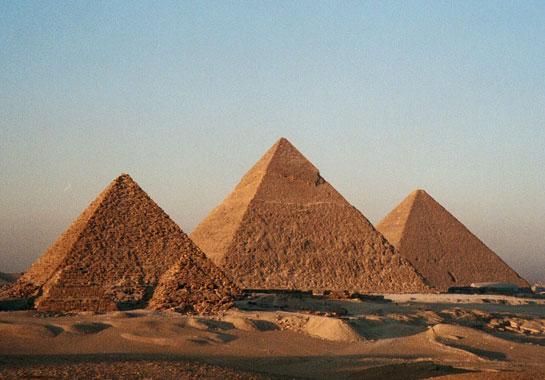
The Great Pyramid of Giza, the largest of the over eighty pyramids in Egypt, is the first Wonder of the Ancient World to be built and the last remaining. They were built four thousand years ago, by the great fourth dynasty Pharoah Khufu, also known as Cheops. The pyramid covers thirteen square acres, and is now 745 ft. (227 m) across, although it was 754 ft. (230 m) before the limestone casing blocks were taken away for building projects in Cairo. The 2,300,000 sandstone blocks weigh from 2.5 tons to 9 tons for the blocks above the King's Chamber, totalling an estimated 6.5 million tons. The pyramid is 449 ft. (137 m) tall, although it was originally 481 ft. (146.5 m) tall, and was the tallest building in the world until the 19th century.
The pyramid is composed of three main chambers: the King's Chamber, which holds a granite sarcophagus that has been empty since at least the 9th century, the Queen's Chamber, and the unfinished chamber. There are two entrances: the main entrance, and the entrance created in 820, which was a short distance away from the main entrance.
The entrances lead into the descending corridor, which goes straight to the unfinished chamber. The ascending corridor meets the descending corridor 97 ft. (29.5 m.) in, and 123.75 ft. (37.7 m) along the ascending corridor is the side passage leading to the Queen's Chamber. The ascending chamber continues into the Grand Gallery leading into the King's Chamber, which has five chambers above it.
The first excavation into the pyramid was by Caliph Abdullah Al Manum in 820, when he broke into the pyramid a short distance away from the disguised main entrance. He searched the pyramid, and the only thing in the monument was the empty sarcophagus. The pyramid was sealed and the only attention paid to it after that was the stripping of the limestone casing to make use of in Cairo.
In 1638, an English astronomer named John Greaves discovered a narrow shaft leading from the junction of the Grand Gallery, ascending corridor, and side passage into a grotto. Soon after the publication of his book, Pyramidographia: A Description of the Pyramids in Egypt in 1646, other explorers took an interest in the pyramid. The first chamber above the King's Chamber was discovered by Nathaniel Davison, an English consul, in 1763. It was at the time filled with guano and had a 2 foot hole in the floor. The guano was eventually cleaned out by an Italian man named Captain Caviglia who resided in the chamber while investigating the pyramid.
In 1837, the most important discoveries were made by the English Colonel Howard Vyse, who discovered two of the casing stones and the air shafts in the King's Chamber. As well, he discovered the rest of the chambers above Davison's Chamber, after noting that a reed inserted into a crack in the roof of Davison's Chamber went three feet without stopping. He was forced to blast an opening to this chamber, which he named Wellington's Chamber.
There are several theories about how the pyramids were built, ranging from slave labor to alien labor. According to Herodotus, it took 100,000 slaves working for 25 years with complicated machines to build the pyramids. Scientists have determined that the pyramid could be finished in 20 years by 2,275 slaves working with ramps to build the pyramids. According to a German named Franz Löhner, 48 men working for 20 years could finish it with rope pulls.
There is also no universally accepted theory about the reason for the construction of the pyramid. The mainstream theory is that is was built as the burial place for Khufu, but he was buried elsewhere, explaining why the pyramid was never finished. Pyramidologists claim that it is a record of Biblical events in stone. The infamous Swiss pseudoscientist Erich von Däniken claims the pyramid is a storehouse for knowledge about everything that could possibly be learned. Some astronomers have suggested that it was an observatory. It is likely that we will never know how or why the pyramid was built.